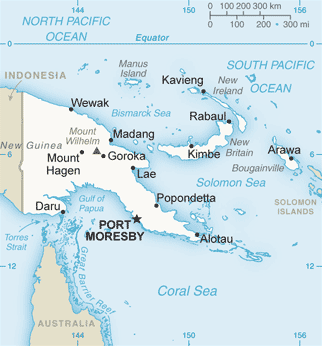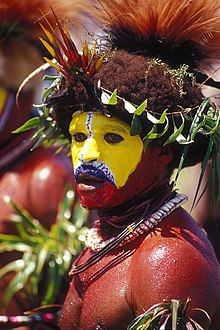Papua New Guinea (PNG) lies 150 miles (240klms) from mainland Australia. It is positioned just south of the Equator with its main island constituting four fifths of its land mass and the remainder made up of hundreds of coastal islands of varying size. The main island is dominated by an extremely rugged east-west central mountain spine with peaks at times over 13,000 feet (about 4,000 metres). This dominant feature is cut by numerous rushing rivers and creeks which, along with volcanic action, have produced areas of soil-rich inland and and coastal lowland fields. The vegetation in the highlands is dominated by thick tropical rain forest, jungle and man-made grasslands.The latter are the by-product of centuries of burning, clearing and planting and the resultant regrowth of vegetation. Along many parts of the coastline the landscape is dominated by many grasslands and swamps. From the air the terrain is viewed as an impressive, rugged impenetrable and inhospitable region.
The climate of PNG is hot and humid and dominated by high rainfall all year long.”The Wet Season” is usually between October and May and, apart from Port Moresby which is in a rain shadow, the rainfall is very high – it rains every day, without warning and falls in torrential downpours. The temperature and humidity is high during the day but can plunge during the nights, while the coastal lowlands remain hot and humid all year round.
Prior to the onset of WWII there were at least seven hundred different languages which demonstrated the isolation and diversity of its inhabitants – a direct consequence of the nature of its geography. In hundreds of isolated little parts of the the country small clans or tribes existed and were based on ‘kinship through marriage, blood lines or adoption’. To use the term “village” is misleading in the PNG context: such groups lived in a small group as three or four families, while others might be part of a hundred or more family groups. All clans had access to their own lands on which subsistence crops were grown: taro, yam, sago, sweet potato, bananas and various leaves of different vegetables. Meat was procured by hunting or catching marsupials, reptiles, fish and pigs. The land was used through and almost ageless cycle – let it dry, burn, plant, reap and move on within the boundaries of your land, allowing the used soil to rest and repeat the cycle.
Huli Wigman from the Southern Highlands
In the highlands there were no roads, hardly any trails and mostly rough hewn tracks known by the locals.
Pre-The Great War PNG was divided into three European “Protectorates”. After the war the British dependency was ceded to Australia and Australia seized the German territory on the Eastern mainland and New Britain and the islands from the Admiralties to Bouganville. Australia established a civil administration in 1920 over the areas it claimed at the Versailles Peace Conference. The period of Papuan history from 1906 to WWII was dominated by Lieutenant Governor Sir Hubert Murray. Murray was born into an Irish-catholic family in Sydney, was an oxford law graduate. When Australia took over Papua in 1906 a Royal Commission was established to determine the best way to administer the territory. The two key issues facing the Commission were how best to deal with land tenure and how to utilise the indigenous people as a cheap labour supply.
Murray chose to allow whites to lease land for the purpose of mining or plantation production. Murray presided over a system whereby local natives signed on as indentured labourers for a period – usually eighteen months. The early period of Murray’s administration were marked by what he called ‘the oil stain’ policy. He deployed small patrols to pierce and pacify the interior with the use of weapons only permissible in self-defence. An outpost or station was like a small drop of oil on water, it spread. By adding other drops in other localities the ‘oil stain’ spread until its edges merged with the adjoining outpost so that patrol officers were in reasonably frequent contact with each other over the length and breadth of the territory. It was a process not unlike that employed by the North-West Mounted Police in Canada during Canada’s formative years.
A Patrol Officer ("Kiap") checking a native canoe.
New Guinea, 1948.
(Photographer: James (Jim) Fitzpatrick. NAA: A1200, L9830)
Hewa patrol leaving camp on a kunai plain. (Photographer: Tom Webster)
Murray died barely two years before the Pacific War came to Papua with a rapidity of defeat and brutality that was to shock the western world and its associated notions of white supremacy. For the white planter, miner, district magistrate or patrol officer – and sometimes missionary – their local knowledge of the terrain and the indigenous people was to prove invaluable. Together with the natives, these white adventurers were to become an intriguing substitute for the modern infrastructure of war.
**************************************************************************




No comments:
Post a Comment